#archeolgst
Text


George Washington's 250-Year-Old Cherries Found Buried at Mount Vernon
Archaeologists found something incredibly rare in the cellar of George Washington's home at Mount Vernon: Two intact jars of cherries buried in the basement of the first U.S. president's house.
Nick Beard, project archeologist at Mount Vernon, said on Tuesday that he had been excavating the basement "for quite a while" when he saw the lip of one of the jars in November.
When the bottle started to peek out from the earth, he proceeded carefully but said he didn't think it would turn out to be anything out of the ordinary, adding that it's common to find wine bottles and glasses at the site about 15 miles south of Washington, D.C.
In fact, Beard stepped away from the bottles to help on a more immediate project. Only when he returned several weeks later did he realize what he discovered.
As he worked, more and more glass became exposed. He tried to wiggle the glass out of its resting place, but when he did his fingers got a little wet.
That's when he noticed whatever he was working on was full of liquid.
"Which means if it's that full of liquid then it has to be intact enough to hold that liquid," said Beard. "That's not common, so that immediately got me excited."
Uncovered jars reveal centuries-old cherries
When Beard further revealed the jars, he called other archeologists to come check his findings.
The jars were fully excavated on March 22. The cherries were removed from the bottles to help preserve the glass, but after April 30, the glass will be sent off for conservation. Its contents will be sent to a lab for analysis and be tested in a controlled environment by specialists, according to a press release from Mount Vernon.
"It's extraordinary," Jason Boroughs, principal archaeologist at Mount Vernon, saying something similar has only happened twice in Virginia in the past six decades:
The latest discovery is a part of the privately funded $40 million Mansion Revitalization Project at Mount Vernon.

What was in the jar?
Beard and Boroughs said that cherries and a mystery liquid were found in the jar. And the cherries, Boroughs said, actually look like cherries, even after hundreds of years.
"They're plump, they have flesh, they have pits and stems," Boroughs said. "They don't look as if they've been sitting in a bottle for 250 years, although they have."
The liquid inside even smelled like cherry blossoms, according to Mount Vernon.
The cherries in the bottles were probably dry when they were buried, Boroughs said.

While the archeologists know what the cherries are, the liquid is still a bit of a mystery.
Lily Carhart, curator of the preservation collections at Mount Vernon, said it's possible the groundwater got into the bottle after the cork that sealed it deteriorated.
The liquid still needs to be tested, Boroughs said. And there is a small possibility it could've been a type of alcohol, like a brandy or cognac.
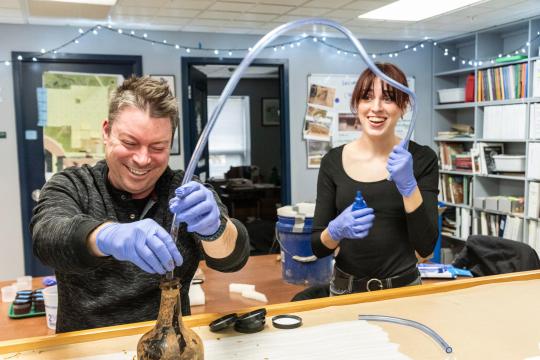

Why were the cherries buried?
Enslaved laborers picked the cherries, wiped them off to avoid condensation and placed them into the jar. Then, that jar was corked and buried sometime between 1758 and 1776, when both George and Martha Washington were living at the home, according to Boroughs.
He added that the method would've kept the fruit inside the bottle preserved for up to a year. It was one of the most popular ways to preserve berries and its how folks in colonial America preserved food before there were refrigerators.
"It pretty much keeps them isolated and sealed from the atmosphere, from air and from fungus and other things that could attack" he said.
According to Boroughs, the cherries were supposed to be served on George Washington's dinner table, but instead were forgotten and buried under a brick floor that was placed in the 1770s, sealing its fate as a sort of a "time capsule."



Can you still eat the cherries?
"You would not want to put that close to your face," Carhart said about the cherries.
Boroughs said that it could actually be possible to eat them, but "nobody wants to try."
Why is this discovery significant?
Boroughs said the discovery is remarkable because he "can't count the number of times 18th-century food remains have been found intact" the way the cherries were.
"We're the first people to touch these objects since they were put in the ground by an enslaved person," Boroughs said.
While the discovery itself is incredible, the archeologist said the stories that can be uncovered from it are just as amazing.
"We think of these items sort of as the material bits of lives that we can recover from the ground," Boroughs said. "These bottles tell stories. They're attached to people who had real lives and if we know how to put the pieces together, we can piece together something about their lives."
Beard added that it feels "surreal" to have such an "immediate connection with the people that lived back then."
By Julia Gomez.



#George Washington's 250-Year-Old Cherries Found Buried at Mount Vernon#Mount Vernon#George Washington#ancient artifacts#archeology#archeolgst#history#history news
32 notes
·
View notes
Text
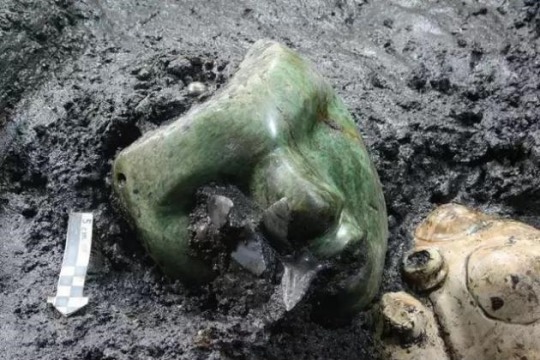
2000 years old green serpentine stone mask found at the base of Pyramid of the Sun, Teotihuacán, Mexico
4K notes
·
View notes
Text

Empires SMP season 2: Pixlriffs / Archeologist !!
I ADORE his outfit and character theme, really creative!
ONE MORE TO GO UNTILL I GOT ALL OF ‘EM!
22 notes
·
View notes
Text
Indiana Jones Sketches

(obligatory terrible camera quality warning)
I wanted to make some sketches of Indy just for fun :)
I’m practicing doing profile drawings, and although these need some work, I’m really proud of them :) I hope you like them too!
14 notes
·
View notes
Text

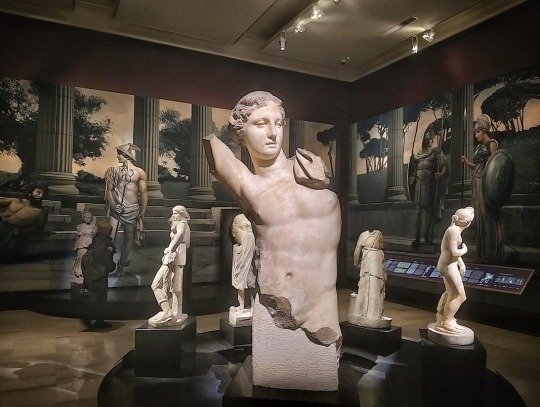
Istanbul Archaeology Museums
37 notes
·
View notes
Text


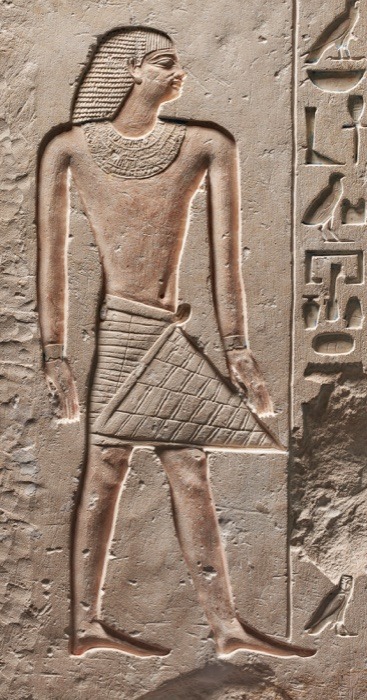
AN EGYPTIAN PAINTED LIMESTONE RELIEF FRAGMENT
OLD KINGDOM, 6TH DYNASTY, REIGN OF PEPI II, CIRCA 2278-2184 B.C.
Pepi II Neferkare (2284 BC – after 2247 BC, probably either c. 2216 or c. 2184 BC was a pharaoh of the Sixth Dynasty in Egypt's Old Kingdom who reigned from c. 2278 BC. His second name, Neferkare (Nefer-ka-Re), means "Beautiful is the Ka of Re". He succeeded to the throne at age six, after the death of Merenre I.
Pepi II's reign marked a sharp decline of the Old Kingdom. As the power of the nomarchs grew, the power of the pharaoh declined. With no dominant central power, local nobles began raiding each other's territories and the Old Kingdom came to an end within a couple of years after the close of Pepi II's reign.
#AN EGYPTIAN PAINTED LIMESTONE RELIEF FRAGMENT#OLD KINGDOM#6TH DYNASTY#REIGN OF PEPI II#CIRCA 2278-2184 B.C.#limestone#limestone sculpture#ancient artifacts#archeology#archeolgst#history#history news#ancient history#ancient culture#ancient civilizations#ancient egypt#egyptian history#egyptian hieroglyphs#egyptian mythology#egyptian antiquities#egyptian pharaoh#egyptian art
15 notes
·
View notes
Text


A FOSSIL GINKGO LEAF
Colorado, USA
From the Paleocene (circa 58 - 55 million years ago) the clearly defined 31⁄4-inch wide Ginkgo cranei with well preserved striations, on original matrix. Reverse of matrix three further partial specimens of Ginkgo cranei.
63⁄4 x 67⁄8 x 3⁄4in. (17.1 x 17.5 x 1.9cm.).
#A FOSSIL GINKGO LEAF#colorado#paleocene period#ginkgo cranei#fossils#archeology#archeolgst#history#history news#ancient artifacts#nature
7K notes
·
View notes
Text
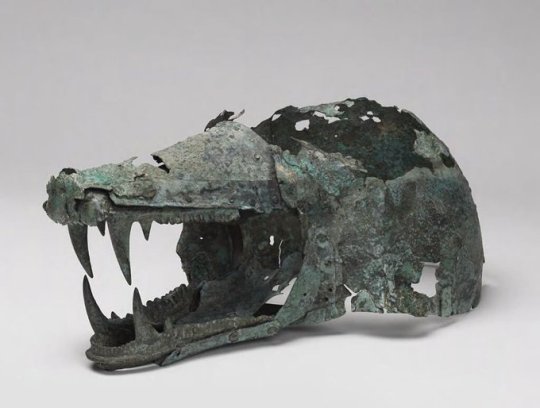
Etruscan Bronze Helmet in the Shape of a Wolf’s Head
6th-5th centuries BCE.
#Etruscan Bronze Helmet in the Shape of a Wolf’s Head#6th-5th centuries BCE#Wolf's Head Helmet#Head of a Boar#bronze#bronze helmet#bronze sculpture#ancient artifacts#archeology#archeolgst#history#history news#ancient history#ancient culture#ancient civilizations#etruscan history#etruscan art
4K notes
·
View notes
Text



Roman Glass Bowl
1st century B.C.
The J. Paul Getty Museum.
#Roman Glass Bowl#1st century B.C.#glass#ancient glass#ancient artifacts#archeology#archeolgst#history#history news#ancient history#ancient culture#ancient civilizations#ancient rome#roman history#roman empire#roman art#blue
2K notes
·
View notes
Text

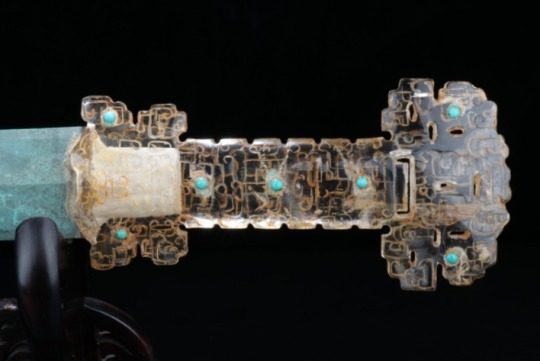
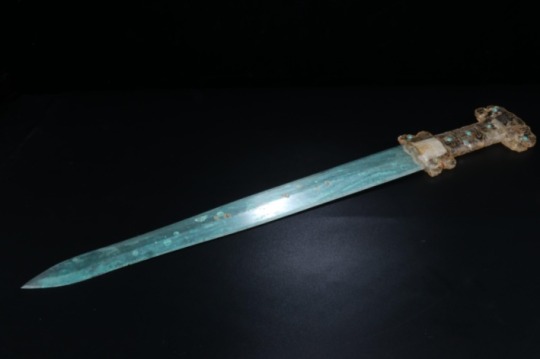
Chinese Bronze Sword With An Inlaid Rock Crystal, Turquoise and Gold Hilt
Warring States Period, Circa 4th - 2nd Century B.C.
#Chinese Bronze Sword With An Inlaid Rock Crystal Turquoise and Gold Hilt#Warring States Period#Circa 4th - 2nd Century B.C.#bronze#bronze sword#ancient artifacts#archeology#archeolgst#history#history news#ancient history#ancient culture#ancient civilizations#ancient china#chinese history#chinese art#art
2K notes
·
View notes
Text
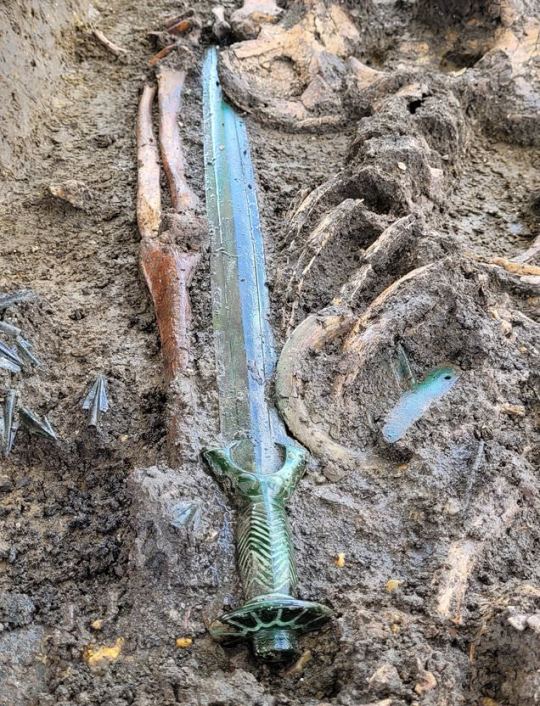
Archaeologists Find a Beautiful 3,000-Year-Old Octagonal Sword in Germany
A rare Bronze Age sword unearthed from a burial site in Germany is in such good condition that it still glimmers.
According to a statement the Bavarian State Office for Monument Protection released on Wednesday, the weapon was discovered in the town of Nördlingen in Bavaria, and may date to the 14th century B.C.
"Last week, archaeologists made a very special find during excavations in Nördlingen: a bronze sword that is over 3,000 years old and is so extraordinarily well preserved that it almost still shines. It is a representative of the bronze full-hilt swords, whose octagonal hilt is made entirely of bronze (octagonal sword type)," a translation of the statement reads.

Its octagonal shape make it a rare find, as only the most skilled blacksmiths were capable of making these types of swords—known as Achtkantschwert in German—that required precise casting and decoration.
"The production of octagonal swords is complex because the handle is cast over the blade (so-called overlay casting). The decoration is made with an inlay and using hallmarks. While there are two real rivets, another pair of rivets are only implied," the statement said.
These rare and specialized swords were only made in two locations in Germany at the time, one in the north, one in the south, although the exact location of this sword's origin could not be confirmed.
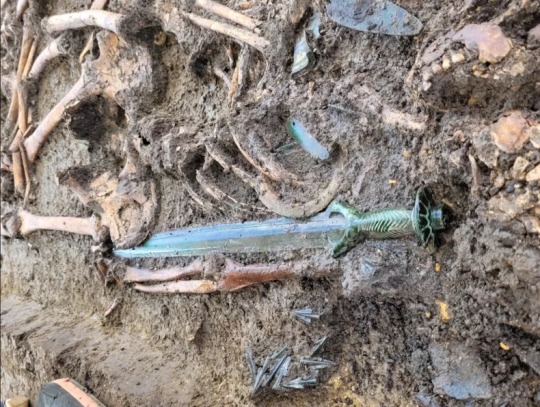
This find is especially unusual considering that most burial mounds in the area of Germany where the sword was discovered have been opened and looted in the past.
"Sword finds from this period are rare and come either from burial mounds that were deliberately opened in the 19th century or as single, presumed sacrificial finds," the statement said.
It is unclear if this octagonal sword was ever used in combat, or if it was a ceremonial blade.
However, archaeologists noted that while the blade had no signs of wear in battle, its center of gravity made it suitable for use as a real weapon, and it was capable of being used to slash opponents.
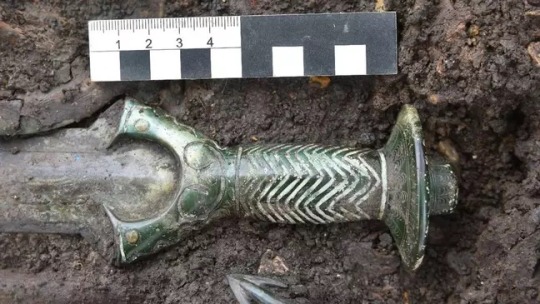
The grave in which the sword was found contained the remains of a man, a woman and a child.
"It is not yet clear whether the persons were related or what the relationship between them was," the statement explained.
Despite these questions, the sword marks an exciting find for the archaeologists and for Germany.
"The sword and the burial still have to be examined further so that our archaeologists can classify this find more precisely. But it can already be said that its condition is exceptional. A find like this is very rare," Mathias Pfeil, head of the Bavarian State Office for the Preservation of Monuments, said in the statement.

#Archaeologists Find a Beautiful 3000-Year-Old Octagonal Sword in Germany#bronze age#bronze Age sword#ancient tomb#ancient grave#ancient artifacts#archeology#archeolgst#history#history news#ancient history#ancient culture#ancient civilizations
4K notes
·
View notes
Text
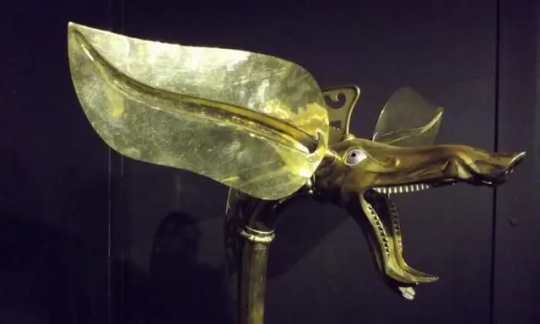

The 'Carnyx' Nightmare of the Roman Soldiers
The Carnyx was a brass musical instrument used as a psychological weapon of war by the ancient Celts between 300 BC and 200AD in western and central Europe and beyond.
The carnyx was once widespread throughout much of Europe, although only a dozen or so fragments are known to us.
It was carried by bands of Celtic mercenaries; it was present at the attack on the Greek sanctuary at Delphi in 279 BC; it defied Julius Caesar in Gaul; and it faced Claudius when he invaded Britain. They are even shown on a Buddhist sculpture in India, proof of the far-flung connections of the Iron Age world.
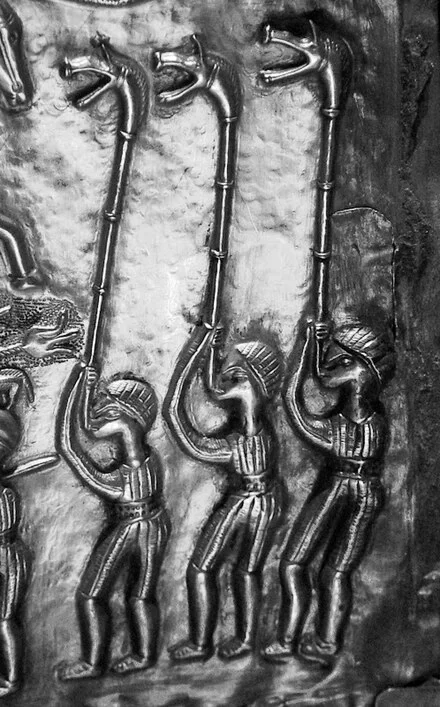
However, they were not only used by the Celts; they were also used by the Dacians in modern Romania. The term “Celtic” is a complicated one. The concept of a pan-European Celtic culture is a myth; rather, aspects of art and technology were shared across vast distances by diverse cultures. The carnyx was one example of this.
A 12-foot-long, thin bronze tube with right-angle bends on both ends made up the carnyx. The lower end ended in a mouthpiece, and the upper end flared out into a bell that was usually decorated to look like a wild boar’s had. Historians believe it had a tongue that flapped up and down, increasing the noise made by the instrument. The carnyx was played upright so that the boar’s head bell protruded well above the warriors’ heads. Its primary goal was to create more noise and confusion on the battlefield.
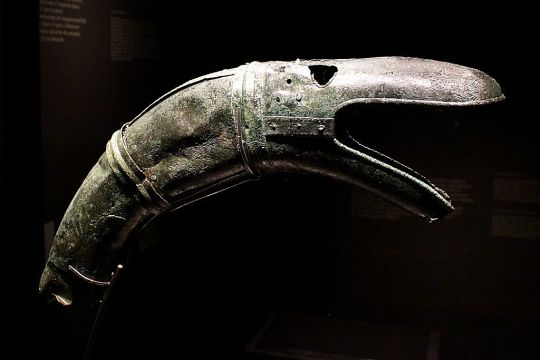
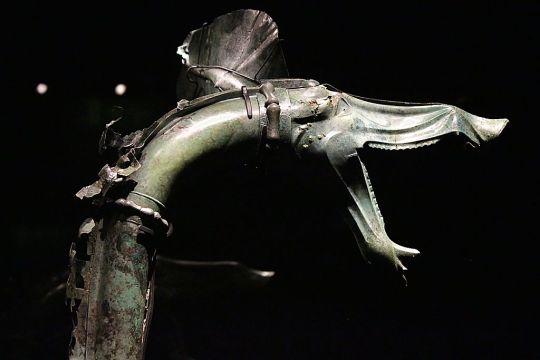

The Greek historian Polybius (206-126BC) was so impressed by the clamor of the Gallic army and the sound of the carnyx, he observed that “there were countless trumpeters and horn blowers and since the whole army was shouting its war cries at the same time there was such a confused sound that the noise seemed to come not only from the trumpeters and the soldiers but also from the countryside which was joining in the echo”.
And the Roman historian Diodorus Siculus wrote, “Their trumpets are also of a peculiar and barbaric kind which produce a harsh, reverberating sound suitable to the confusion of battle.”
Archaeologists discovered a hoard of ritually destroyed weapons in 2004, including a dozen swords, scabbards, spearheads, a shield, bronze helmets, an iron helmet shaped like a swan, a cauldron, animal remains, and seven carnyces. Before the Tintignac discovery, the remains of only five actual carnyces had been found.
The finest was unearthed in Deskford, Scotland in 1816. The Deskford carnyx only has the boar’s head bell and is missing the mane, tongue, and tubing. Images of Carnyx players have been found as well. A Roman denarius, dating from 48 BC bears a representation of a Carnyx. Three carnyx players are featured prominently on the Gundestrup Cauldron, which was found in a Danish peat bog.
One of the seven found at Tintignac, on the other hand, was almost entirely complete. The Tintignac Carnyx was broken into 40 pieces. When puzzled back together, it was found to be just an inch short of six feet long with a single missing section of the tube. The bell was a boar’s head with protruding tusks and large pointed ears. Once restored, the Tintignac Carnyx proved to be the first virtually complete carnyx ever found.
By Leman Altuntaş.
Music video by John Kenny.
#The Carnyx#The 'Carnyx' Nightmare of the Roman Soldiers#Iron Age war trumpet#ancient artifacts#archeology#archeolgst#history#history news#ancient culture#ancient civilizations#celtic mythology#celtic history#roman history#roman empire#roman legion
2K notes
·
View notes
Text

Medieval Toy Unearthed in Poland
A 800-year-old horse figurine was found during an excavation conducted as part of the construction of a new fire station in Toruń, a medieval town on the Vistula River in north-central Poland. The small clay horse was glazed and has a hole in its underside. Researchers think a stick may have fit into the hole so that playing children could pretend to make the horse gallop or use it as a puppet.
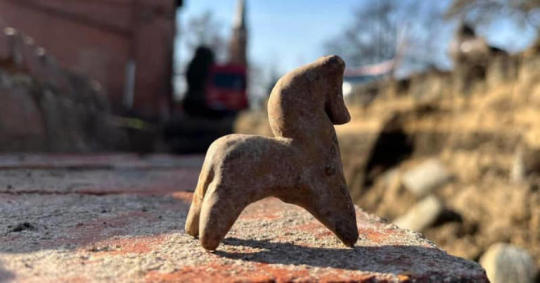
#Medieval Toy Unearthed in Poland#A 800-year-old horse figurine#Toruń#ancient artifacts#archeology#archeolgst#history#history news#ancient history#ancient culture#ancient civilizations#medieval history
878 notes
·
View notes
Text
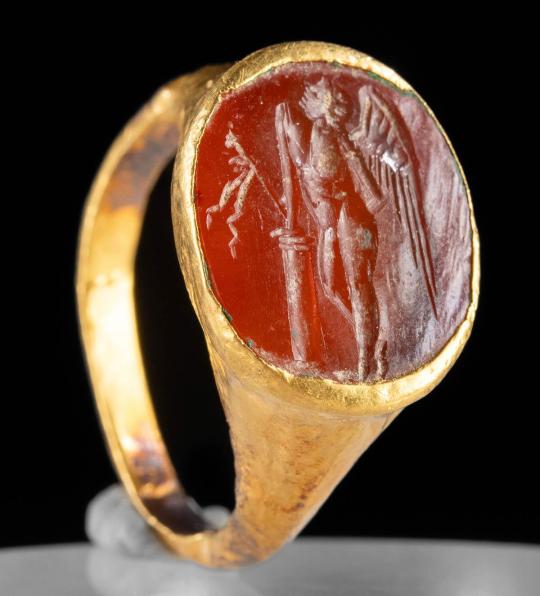
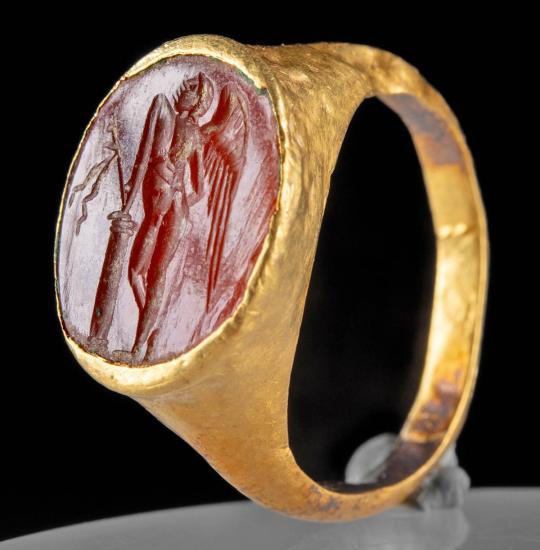
Roman Gold Ring w/ Carnelian Intaglio, Leaning Cupid
Imperial period, ca. 1st to 3rd century CE
#Roman Gold Ring#Imperial period#ca. 1st to 3rd century CE#gold#gold jewelry#ancient jewelry#ancient artifacts#archeology#archeolgst#history#history news#ancient history#ancient culture#ancient civilizations#ancient rome#roman history#roman empire#roman art
643 notes
·
View notes
Text
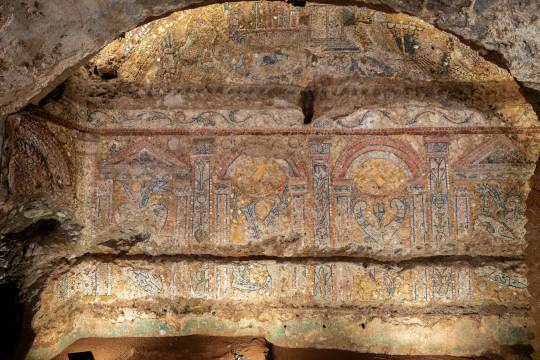
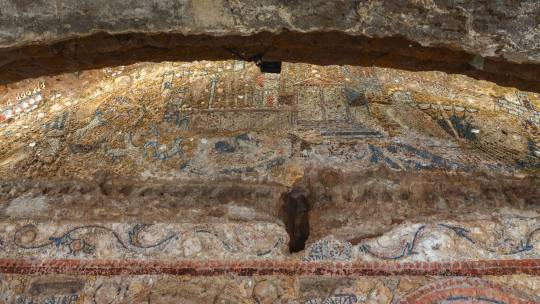
‘Incredible’ Mosaics Were Found in an Ancient Luxury Home in Rome
Italy’s Culture Minister Gennaro Sangiuliano has called the works “an authentic treasure.”
Researchers working in the Archaeological Park of the Colosseum in Rome have shared their discovery of luxurious mosaic-tiled rooms found in an ancient home on the site, which they believe may have belonged to a Roman senator. Created from shells, glass, white marble, and Egyptian blue tiles, the mosaics have been described by Italy’s Culture Minister Gennaro Sangiuliano as “an authentic treasure”.
The “rustic” mosaics, found on the grounds surrounding the Colosseum in the heart of the city, date to the late Republican Age, in the last decades of the second century B.C.E., and show a series of figurative scenes. They once decorated a townhouse, or domus, owned by an upper class citizen. Italy’s Ministry of Culture have said that “due to the complexity of the scenes depicted” and their age, the mosaics are “without comparison.”

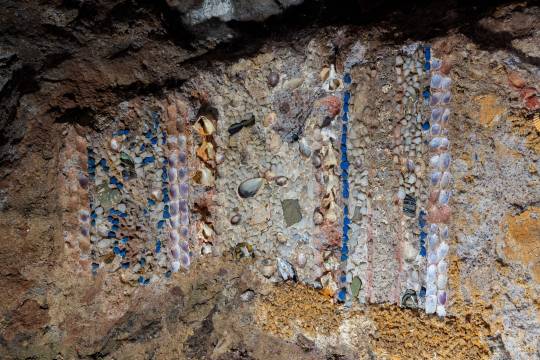

One mosaic depicts a coastal city with towers and porticos, with three large ships floating by on the ocean waves. The culture ministry believes this could be a reference to naval victories achieved by the owner of the home, which is believed to have been a Roman senator. This is supported by historical sources describing the area as having been occupied by such high-ranking members of society.
The decorated walls were likely located in the home’s dining rooms, where luxurious banquets would be hosted, and guests at these events were likely wowed with “spectacular water games,” according to the culture ministry, based on the presence of lead pipes set into the walls.
In the reception room, an extremely well preserved decorated stucco featuring landscapes and figures was also discovered. Other designs include vines and lotus leaves flowing from vases, musical instruments, and tridents.

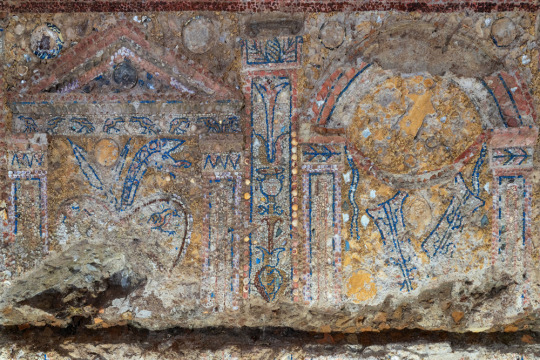

The mosaic walls were first discovered near the Colosseum in 2018, but excavation at the site will continue into 2024, and more rooms could be discovered. Alfonsina Russo, the Director of the Archaeological Park of the Colosseum, has said that once the domus is full uncovered, “we will work intensely to make this place, among the most evocative of ancient Rome, accessible to the public as soon as possible.”
By Verity Babbs.
#‘Incredible’ Mosaics Were Found in an Ancient Luxury Home in Rome#Archaeological Park of the Colosseum#Late Republican Age#second century B.C.E.#mosaic#roman mosaic#ancient artifacts#archeology#archeolgst#history#history news#ancient history#ancient culture#ancient civilizations#ancient rome#roman history#roman empire#roman art
1K notes
·
View notes
Text


Ancient Roman Bronze Mice
c.2nd century AD
#Ancient Roman Bronze Mice#c.2nd century AD#bronze#bronze sculpture#ancient artifacts#archeology#archeolgst#history#history news#ancient history#ancient culture#ancient civilizations#ancient rome#roman history#roman empire#roman art
499 notes
·
View notes